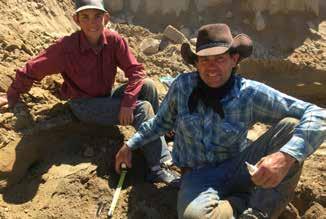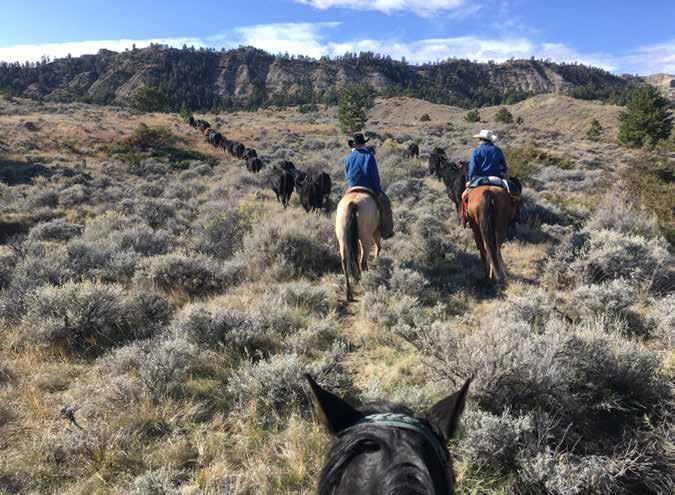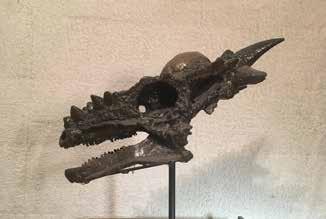
9 minute read
Diggin’ up bones
BY MARIA TIBBETTS
The West is strewn with bones. The bones of cattle that couldn’t make another winter, deer that didn’t outrun coyotes and coyotes that couldn’t outrun disease.
But as wind and weather move the soil in a cycle older than time, other bones surface. Bones of bison that once roamed the Plains. Deeper still are the bones of creatures humans have seen only in movies and museums.
The bones of animals that weighed twice as much as an elephant and were designed for ripping flesh weather out of the sagebrush draws and cutbanks in several Western states, and some ranch families are turning hunting dinosaurs into as much of a way of life as raising cattle.

Jake Harris (center), his dad Mike (right) and their neighbor, Aaron Bolan were featured in Dino Hunters, a reality show on Discovery Channel. Photo courtesy of Discovery Channel.
Jake Harris and his dad, Mike, run Angus cattle near Newcastle, Wyoming, but over the last 20 years they’ve become experts at identifying, excavating and preserving dinosaur fossils. The ranch is on what’s known as the Lance Creek Formation, a geologic formation that stretches across Montana, Wyoming, North Dakota and South Dakota. The Lance Creek Formation dates to the Cretaceous period, estimated to be about 66 million years old.
“I was just riding along 20 years ago, and said, ‘Hey, look at that,’” said Jake. “It didn’t look like a cow bone, and we knew we were in the Cretaceous. We probably rode over it a million times on horseback. We started digging. It turned out to be the humerus of a Edmontosaurus, or duckbill dinosaur. I’ve been hooked ever since.”
Once they’d figured out they were dealing with dinosaur fossils, they got in touch with professionals like Pete Larson at Black Hills Institute of Geologic Research to verify their finds, and Walter “Bill” Stein, who taught them how to preserve the fossils.
The Harris family built a lab on their ranch and now do their own excavating and preserving, calling in the experts only to identify unfamiliar fossils.
So far they’ve found representations of Triceratops, Ankylosaurus, Tyrannosaurus rex, Hadrosaur, Nanotyrannus, Dracorex, Troodon, Anzu, and Pachycephalosaurus, plus gar scales, crocodile scales and teeth, and turtle fossils. “We have the fourth-most complete T. rex in in the world,” Jake said. Their collection also includes two of the top 10 Triceratops skulls in the world. They donated one of those skulls to a museum in Missouri for research.
“If you find any dinosaur over 70 percent, you’d better go buy a lottery ticket because that’s a find. You’re extremely lucky if you get over 50 percent of a skeleton,” Jake said. “We had an 80 percent complete Triceratops. We already had it under contract. It was at our secondary prep lab and they were building stands for it, when a 100- year flood washed through. We got four bones back. You can’t insure dinosaur skeletons. Talk about a bad day.”
The gamble and the risk is familiar for the ranching family. The same weather that exposes the fossils for finding, quickly breaks them back down into gravel.
It’s the wind and water that makes dinosaur hunting an ever-changing pursuit, Jake said. A dry year, like this one has been, is good for digging bones, but doesn’t usually expose many new ones. Wind--always plentiful in Wyoming--moves the dirt from one spot, but puts it down in another, so it may be burying some bones as it’s uncovering others.

Jake Harris was a teacher who came back to help on his family’s ranch and now spends summers digging dinosaur bones. PHOTO COURTESY OF DISCOVERY CHANNEL.
Jake said he’s not concerned about running out of dinosaurs to find. “There will still be dinosaurs here for my kids and grandkids--if I ever have any,” he said.
Dinosaur hunting is more than just wandering around kicking at the dirt. Jake said they know where they’ll have the best luck by looking at the layers of soil and using a GPS to determine their elevation. There’s a gray tint to the shale around the dinosaur fossils, and about 80 percent of their success has been in that layer of the soil.
“I walk the same draws every year and find new sites every year,” Jake said.
Once the fossils are removed, they replace the soil they moved, and return it to the pre-dig condition, or better, Jake said. The average site he’s worked on is usually less than an acre, so reclamation of those sites isn’t too difficult.
The dinosaurs pay rent on the place they’ve been occupying for millions of years, but finding a great skeleton doesn’t always translate to a great payday. The Harrises found a Tyrannosaurus rex skeleton, which they named Cowboy Rex, several years ago. It’s been sitting in their lab ever since, waiting for the buyer who has both the interest and the resources to purchase, prepare and display a specimen that’s worth millions.
The Harrises put together a website, www.wyomingdinosaurranch.com, where they sell authentic and replica specimens they’ve found on their ranch. They also have a network of buyers, from private collectors to museums, they work with on more significant finds. The website lists authentic fossils from a Struthiomimus toe bone for $120 to a Triceratops jawbone for $4,495.
While the Harrises haven’t found a buyer for Cowboy Rex, they at least seem to have escaped the “curse” that attends the discovery of a lot of T. rex skeletons. Many of the major carnivore finds have ended up in court, eroding profits and wrecking the relationships between landowners and dinosaur hunters or ranch owners and mineral rights-holders.
Clayton Phipps, a rancher and dinosaur hunter from Montana, just got a final answer on a dispute he’s been involved in for years.
Clayton got his start as a dinosaur hunter when he was cowboying on a ranch in Montana. A fossil hunter started looking around and before he left he showed Clayton some of the dinosaur fossils he’d found. Clayton had spent his childhood scanning the ground for arrowheads, so the new hobby wasn’t hard to pick up. He just kept an eye out when he was riding, and spent his free minutes looking for dinosaurs. “I started going around to museums, I wanted to learn everything about it, and it just kind of took off from there,” Clayton said.

Clayton Phipps and his son, Luke, have been digging together since Luke was born. COURTESY PHOTO.
Clayton’s family--his dad and his dad’s three brothers-- ranched in Montana on three ranches. When three of the brothers died, the families split the ranches four ways. Clayton and his brother and sister split their part of the ranch three more ways, so Clayton was left with enough to run a few cows, but not make a living.
For a while he cowboyed for extra income, but decided, after he’d been dinosaur hunting for a while, that he wanted to quit riding for hire and start supplementing the ranch with the dinosaurs. “My wife still thinks I’m crazy, but I’ve managed to scrape a living out of the country,” he said. “Quite frankly, it’s paid the bills better than ranching.”
Clayton runs some of his own cows, and some for a neighbor. Summers are mostly for dinosaur hunting, and the routine summer work of ranching, but he has to take off a few weeks to put up hay. “The equipment I have been able to afford is older than I am, and me and mechanicing don’t agree. I’d rather hunt dinosaurs.”
Clayton and his hunting partner, his 13-year-old son, Luke, have found some fossils on the ranch where his family lives, but they also prospect on other landowners’ ranches.

Clayton Phipps and his family ranch in Montana, where Clayton got his start digging up dinosaurs. COURTESY PHOTO.
As a rancher himself, Clayton says he has the utmost respect for the landowner and does his best to keep those relationships in good standing. It’s that partnership that led him to supporting a lengthy legal battle over the skeletons of a carnivore and herbivore that died while fighting, called “the dueling dinosaurs.” Clayton discovered the dinosaurs in 2006, but after they were removed, the owner of the mineral rights to the land where they were found challenged the landowners’ claim to them. The 9th Circuit Court ruled this summer that fossils are part of the surface rights, reaffirming the precedent the industry has been working under for more than 100 years.
In 2019 the Montana legislature passed a law stating that fossils are part of the surface rights, thanks to this court case. Clayton and his son, Luke--12 at the time-- both testified in favor of the bill. It was passed unanimously and signed by the governor.
When millions of dollars are at stake, the handshake relationships ranchers prefer are tested, and sometimes fail. But, as Clayton points out, it’s a partnership, and without the right people finding, digging up and preserving the dinosaur fossils, they’re worthless. And if the fossil hunters don’t have a place to hunt, they don’t have a job.
“More than half the value is in preparation and how well you do your job there,” he said. “That doesn’t count the time it takes to dig it out of the ground, or the 20 years it took to find it.”
While the Harrises do their own excavation and prep, Clayton partners with fossil preppers, CK Preparations, to do the job for him. “The labwork makes a big difference. You can destroy a dinosaur getting it out of the ground. I can prep the small stuff, but when it comes to the big stuff, they do it. It takes a lot of time and knowledge and effort to make a museum quality display.”
But if you can’t find a buyer, all the time, effort and expense won’t pay off. Like Harris’s Cowboy Rex, the best Hadrosaur skeleton Clayton ever found is still sitting in storage. “It’s 18-feet long, complete with tail. There was skin with the specimen. But we can’t find a home for it. Just because you find a dinosaur doesn’t mean you have it made, or you’ll get to the bank with a check.”
While the larger skeletons with bigger price tags are sometimes problematic to sell, nice specimens that are well-preserved can help pay a few bills. Clayton found a Stygimoloch skull, which is on display at a museum in Long Island, New York, and a replica is at the Garfield County Museum, in Jordan, Montana. Clayton also discovered a new species of oviraptor that is still being studied at the Royal Ontario Museum in Toronto.

A Stygimoloch skull that Clayton Phipps found. The original is on display in Long Island and a replica is at the local museum in Jordan, Montana.
There may be other ways for the dinosaur ranchers to add some value to their fossil finding. Clayton’s brother, Jason Phipps, offers paid dinosaur digs for visitors at their ranch near Jordan, Montana. Jake said they welcome visitors and may offer a similar
The two families are also becoming familiar faces to 4.5 million viewers of Discovery Channel’s series, Dino Hunters. In 2019 Half Yard Productions followed Phipps and Harris, plus two other dinosaur hunters, around for several days, filming for the reality show. It was a unique experience, wearing a microphone (and the same shirt) day after day, all day, Jake said.
“The one thing is it took a lot more time than I thought it would,” said Clayton. “We had some great film crews. I can’t say it was the funnest thing I’ve done in my life, but it’s not something I mind.” Discovery Channel aired six episodes of the series, and averaged more than 1.1 million viewers per week.
Follow the dinosaur ranchers online
Jake and Mike Harris Facebook: @WyomingDinosaurRanch Instagram: @cretaceouscowboy Website: Wyomingdinosaurranch.com
Clayton Phipps Facebook: @TheDinosaurCowboy www.cowboydinodigs.com
CK Preparations www.ckpreparations.com
Discovery Channel www.discovery.com/shows/dino-hunters You can stream the shows on the Discoery Go app.








